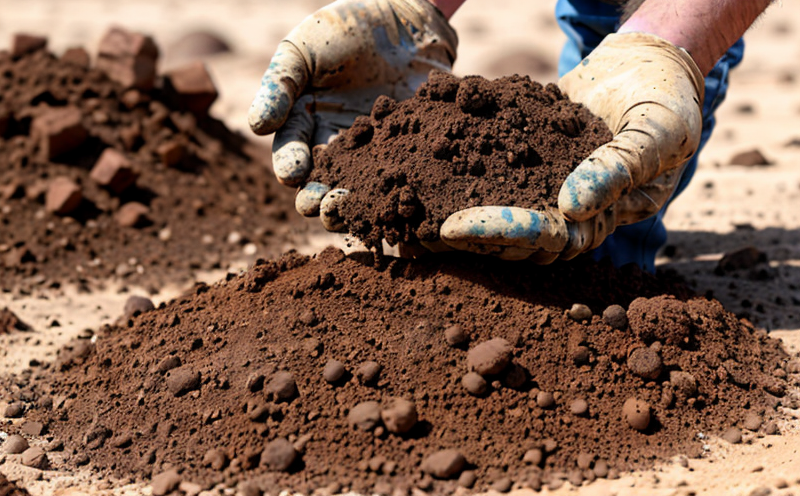BS 1377 Part 5 Atterberg Limit Testing of Soils
The British Standard (BS) 1377 Part 5 describes procedures for determining the liquid limit, plastic limit, and shrinkage limit of soils. This test is particularly crucial in mining testing as it provides essential data on soil behavior under varying moisture conditions. Understanding these limits is vital for predicting soil stability, ensuring the safe design and construction of mine infrastructure, and managing overburden during excavation.
Atterberg limits are fundamental in geotechnical engineering and environmental science, especially when dealing with fine-grained soils such as clay, silt, and silty sands. These limits help engineers determine the moisture content at which a soil transitions from a solid state to a plastic one (plastic limit) or from a liquid to a semi-solid state (liquid limit). The shrinkage limit is also important as it indicates the point of maximum volume reduction during drying.
The Atterberg Limit Testing of Soils, following BS 1377 Part 5, involves several steps. Initially, samples are prepared by air-drying and then crushed to a specific size range. The sample is then rewetted until it reaches the consistency required for testing. A standard cone penetrometer is used to measure the penetration resistance of the soil at different moisture contents. This process allows for accurate determination of the liquid limit (the moisture content when the soil begins to lose its strength), plastic limit (moisture content where the soil ceases to be plastic and becomes brittle), and shrinkage limit.
The data obtained from this test is not only critical in mining operations but also in other sectors such as civil engineering, construction, and environmental management. It helps in assessing the suitability of soils for foundation design, determining appropriate moisture content for backfilling materials, and evaluating the potential for landslides or subsidence.
For instance, in a mining context, the Atterberg limits can influence decisions on the placement of waste rock dumps or tailing ponds. Ensuring that the soil used is within acceptable limits helps prevent unstable conditions that could lead to safety hazards. This testing also supports regulatory compliance and ensures that operations meet international standards such as ISO 17892-4, which covers the determination of shrinkage limit.
The precision and accuracy of Atterberg Limit Testing are paramount in ensuring reliable results. Proper sample preparation and consistent application of test procedures are essential to avoid errors that could lead to suboptimal decisions. The use of calibrated instruments such as penetrometers ensures that measurements are accurate, which is crucial for the integrity of any geotechnical assessment.
In conclusion, BS 1377 Part 5 Atterberg Limit Testing of Soils is a cornerstone in mining testing and environmental science. Its ability to provide detailed insights into soil behavior under varying moisture conditions makes it indispensable for ensuring safety, compliance, and efficiency in mining operations.
Why Choose This Test
- Precision in Soil Characterization: The BS 1377 Part 5 test provides a high degree of accuracy in determining the liquid limit, plastic limit, and shrinkage limit of soils.
- Regulatory Compliance: Adherence to international standards ensures that your operations meet regulatory requirements, which is crucial for compliance.
- Informed Decision-Making: Accurate soil data helps in making informed decisions regarding the suitability of materials and conditions for mining operations.
- Enhanced Safety: Understanding soil behavior through this test can prevent potential hazards such as landslides or subsidence, enhancing safety measures.
- Economic Efficiency: By ensuring that soils are within acceptable limits, costs associated with corrective actions and rework are minimized.
- Sustainability: Proper use of soil materials helps in sustainable practices by reducing the environmental impact of mining activities.
Customer Impact and Satisfaction
By leveraging BS 1377 Part 5 Atterberg Limit Testing, customers can expect enhanced operational efficiency and safety. The detailed insights provided into soil behavior allow for more precise planning and execution of mining projects. This not only ensures that operations are carried out safely but also within regulatory frameworks.
The testing process is designed to be robust, ensuring consistent results across different sites and samples. This consistency allows for better predictability in the performance of materials used in mining operations. As a result, customers can trust the reliability of the data obtained from these tests, leading to increased satisfaction levels.
Moreover, the use of international standards such as ISO 17892-4 and ASTM D5668-05 provides an additional layer of confidence for customers in terms of quality assurance. The ability to demonstrate compliance with these standards is particularly beneficial when dealing with regulatory bodies or stakeholders.
The precision of the test also extends beyond immediate operational benefits. By providing accurate data, it aids in long-term planning and strategic decision-making. For instance, understanding soil behavior can inform future projects by highlighting areas where further research or investment may be required. This forward-thinking approach contributes to overall customer satisfaction and trust.
Environmental and Sustainability Contributions
The BS 1377 Part 5 Atterberg Limit Testing plays a crucial role in environmental sustainability by ensuring that mining operations are conducted responsibly. By providing accurate data on soil behavior, the test helps minimize the ecological impact of mining activities.
One key aspect is the reduction in waste generation and potential contamination. Proper use of soils ensures that materials used do not lead to unnecessary spoil or waste, which can otherwise contribute to environmental degradation. Additionally, understanding shrinkage limits allows for more efficient use of resources, reducing overall consumption and associated emissions.
The test also supports reclamation efforts by providing data on soil properties that are essential for successful revegetation and habitat restoration post-mining operations. This contributes to the broader goal of sustainable development in mining practices.
Furthermore, compliance with international standards such as ISO 17892-4 ensures that mining activities align with global sustainability goals. By adhering to these standards, mines can demonstrate their commitment to environmental stewardship, thereby enhancing their reputation and standing within the industry.





